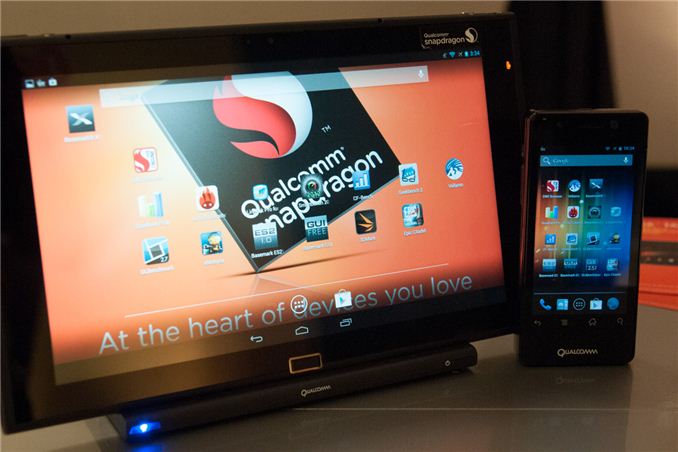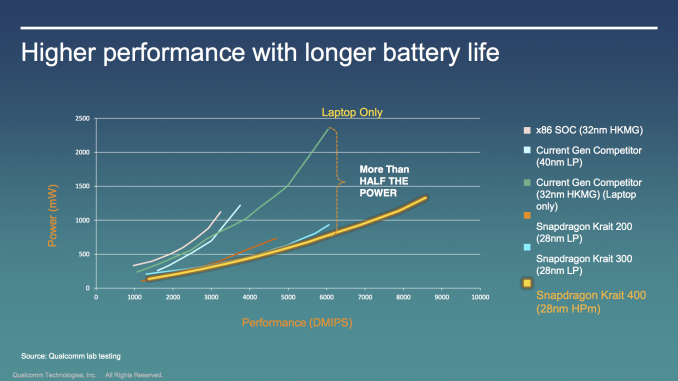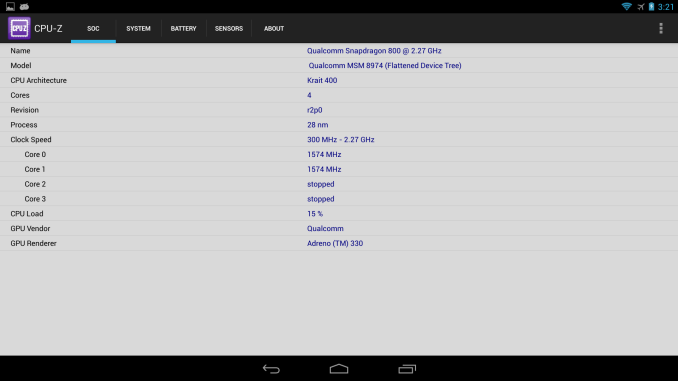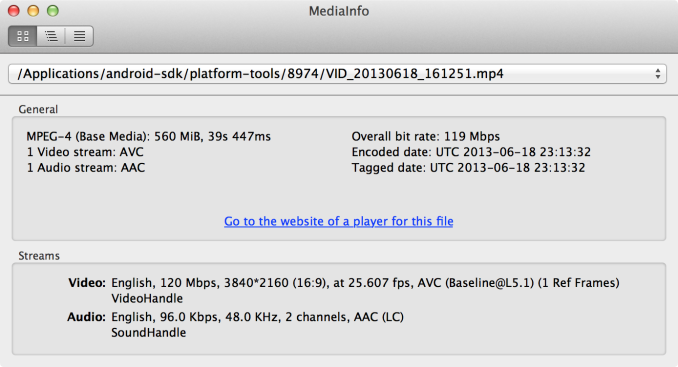Snapdragon 800 (MSM8974) Performance Preview: Qualcomm Mobile Development Tablet Tested
by Brian Klug on June 18, 2013 8:00 PM EST
We’ve written about Snapdragon 800 (MSM8974) before, for those unfamiliar, this is Qualcomm’s new flagship SoC with four Krait 400 CPUs at up to 2.3 GHz, Adreno 330 graphics, and the latest modem IP block with Category 4 LTE. Qualcomm is finally ready to show off MSM8974 performance on final silicon and board support software, and invited us and a few other publications out to San Francisco for a day of benchmarking and poking around. We looked at MSM8974 on both the familiar MSM8974 MDP/T, a development tablet used both by Qualcomm and 3rd parties to develop drivers and platform support, and the MSM8974 MDP phone, both of which have been publicly announced for some time now.
The tablet MDP is what you’d expect, an engineering platform designed for Qualcomm and other third parties to use while developing software support for features. Subjectively it’s thinner and more svelte than the APQ8064 MDP/T we saw last year, but as always OEMs will have the final control over industrial design and what features they choose to expose. Display is 1080p on the tablet and 720p on the phone, a bit low considering the resolutions handset and tablet markers are going for (at least 1080p on phone and WQXGA on tablets) so keep that in mind when looking at on-screen results from benchmarks.
| Qualcomm Snapdragon 800 Mobile Development Platform Tablet | |
| MSM8974 MDP/T | |
| SoC | MSM8974 Snapdragon 800 |
| CPU | 4x Krait 400 at 2.3 GHz |
| GPU | Adreno 330 at 450 MHz |
| RAM | 2GB 2x32 LPDDR3 800 MHz |
| NAND | 32 GB eMMC 4.5 |
| Cameras | 12 MP with flash (rear), 2 MP (front) |
| Display | 11.6-inch 1080p |
| I/O | USB 3.0, microHDMI, microSD, 3.5mm headset |
| OS | Android 4.2 |
Snapdragon 800, nee MSM8974 is built on TSMC’s 28nm HPM (High Performance for Mobile) HK-MG, as opposed to 28nm LP polysilicon (low power). The result are higher clocks for CPU, from 1.5–1.7 GHz on Krait 200–300 which was 28nm LP, to 2.2–2.3 GHz on Krait 400 on 28nm HPM. The jump between Krait 200 and Krait 300 brought higher clocks and also a jump in IPC, this time around Krait 400 is essentially a Krait 300 implemented on 28nm HPM, which means some relayout. There’s also a faster L2 cache on Krait 400.
These are final clocks on MSM8974 – Krait 400 runs its four cores at up to 2.3 GHz, though some lots will come at 2.2 GHz. GPU on MSM8974 is Adreno 330 which runs at 450 MHz and brings some architectural improvements over Adreno 320.
On the video side, MSM8974 is capable of encoding UHD 4K (3840 x 2160) 30 FPS video at up to 120 Mbps H.264 High Profile, and is capable of playing back the same file. Qualcomm had a demo going showing this mirrored on the latest Sony 4K UHD TV as well over microHDMI. I recorded a video sample and took a copy for your perusal and onto YouTube. True to their word the video I grabbed is 120 Mbps and 3840 x 2160, framerate was just over 25 FPS but I'm not sure if the demo was setup for 30 FPS capture. MSM8974 has the hardware encoder for H.264 but not HEVC H.265, that's implemented in software.
Snapdragon 800 should begin popping up in phones and tablets fall 2013. Anyhow let's take a look at MSM8974 performance.

























115 Comments
View All Comments
shodanshok - Sunday, June 23, 2013 - link
You are right :) The 2 GHz / 2 Watt rating was at 40nm. It was explicity called at ARM site, so I didn't specified that above.Anyway, lacking NEON instructions means nothing for CoreBech, as it don't test vector code.
Regards.
Wilco1 - Sunday, June 23, 2013 - link
Coremark can be vectorized, which one reason why the scores have improved. Tegra 2 was terrible in most respects, Exynos 4 and Calxeda are currently the best A9 implementations until Tegra 4i is released. Obviously it will be very interesting to see how Silvermont will do against Tegra 4i.Wilco1 - Sunday, June 23, 2013 - link
Now we've agreed that A9 can reach similar frequencies then we can normalize on frequency, yes? When you normalize on frequency then in-order vs OoO matters more, which is what I said all along.1. NVidia has shown their 2.3GHz Tegra 4i reference phone which should be on the market soon. The reason you don't see 2GHz A9 phones today is (a) use of older processes and (b) use of quad cores which leads to too much power use at high frequencies. If they were single or dual core then it would be easier to go for 2GHz.
2. Atom only supports dual core (even Centerton is dual core trying to compete with the Calxeda quad core...), and until the recently released K900 I believe all Atom phones were single core. On the other hand most smart phones have been quad-core since 2012.
3. I still don't see where you think that A9 is slower per core than Atom. At the same frequency it is unbeaten even if you give Atom the advantage of Hyperthreading.
4. If you say that a core with HT is just a single core then surely it should look like a single core to software as well and provide a speedup to single-threaded applications? As soon as you enable HT for a multithreaded application then it would be unfair to compare with single threaded performance on a non-HT core. You can't just pick and choose a comparison that gives one core a major advantage over another.
So far I haven't seen any evidence of native benchmarks where Atom is clearly faster. If you do a fair like for like comparison then A9 wins every time. However if you remove the advantages from one core but keep all the advantages for another then you can of course prove whatever you like.
shodanshok - Sunday, June 23, 2013 - link
1) During Atom lifetime as competent product (read: before A15 release), _no_ phone (or tables, to best of my knowledge) shipped with A9 faster then 1/1.2 GHz. Even Scorpion based phones had higher frequencies. Anyway, from the Coremark comparison written above, you can see that normalizing core/frequency lead to similar per-core performance between A9 and Atom. With the difference that Atom shipped at generally higher frequency, even @ 2.0 GHz: http://www.anandtech.com/show/6307/motorola-hits-2...Comparing a 5-year-old Atom to a to-be-shipped Tegra 4i which as tweaked cores seems fair? I think no.
2) For scaling above 2 cores, currently Atom use FSB communication. However, I can not see why you need 4 Atom cores in a phone. Anyway, you have a point here (on-chip communication are much more pratical) ;)
3) HT is a simple, cheap method to increase total tput. You can not consider an HT-enabled Atom as having 2 cores. Even on coremark sites an HT-enabled Atom is considered a one-core processor. I reiterate: how to consider a barrel processor? A many core approach?
4) You can find many benchmark were Atom excels... some example:
a) http://www.anandtech.com/show/5770/lava-xolo-x900-... (OS android - browser benchmark + linpack + other)
b) http://www.anandtech.com/show/6529/busting-the-x86... (OS WinRT / Win8 - many web brower benchmark)
You can not mark all web browser benchmark as "flawed". Sure they are not 100% uarch dependant, but they are a good method to evaluate the entire software stack used by these processors.
Regards.
Wilco1 - Sunday, June 23, 2013 - link
1. Not true - A9 was running at 1.4GHz in 2011 products, 1.5GHz early 2012 and 1.7GHz late 2012. So A9 was most definitely available at higher frequencies, including in phones (One X). With the shrink to 28nm it gets another boost to 2.3GHz. So in frequency it can match or beat Atom (note by the time it comes out, it'll be compared with Silvermont which achieves similar frequencies).3. Yes a barrel processor looks and behaves like multiple slow cores. The fact that they share hardware in a very specific way is an implementation detail. An equivalent approach would be multiple independent cores. Do you consider a Bulldozer module as a single core as well?
If you prefer to just compare a single core then you should only consider its single threaded performance. As soon as you compare multithreaded performance, then it is completely fair to allow each CPU designer to decide how to implement that, whether it is with HT/SMT, multiple cores or AMD's inbetween approach. You're right of course that HT is a fairly cheap way of adding more threads if you already have a complex core - using multiple cores is only a good idea if you designed your core to be as small as possible.
4. Anand is the worst place to look for CPU benchmarks. Most are JavaScript benchmarks which can vary by a factor of 2 even on the same browser. And his Linpack test is more a Dalvik test than about FP performance. Although there are cases where performance of a browser is important (things like rendering pages), we are discussing micro architecture performance, not how the Android software stack performs.
shodanshok - Monday, June 24, 2013 - link
1) Almost all widespread phone had A9 running at 1.0/1.2 Ghz for so much time. Only recently they increased their frequency at about 1.4 Ghz, and atom is @ 2.0 GHz now.2) "Look as" is not the same as "it is". So a T2 is the equivalent of a 128 core machine? Really? You are confusing SMP with SMT. Look at coremark results: a quad core A9 has performance 4x of a single core, and the score/core reflect this (it is the total score divided by 4). Quad thread Atom instead is a two core uarch, only slightly (30%) faster when tested with 4 thread instead of 2. In fact, coremark/core score is obtained dividing the total score by two, even if the test run with 4 threads. Even coremark developers are wrong?
3) All the posted benchmark,with the exception of Geekbench, show how Atom single core performance are better then A9. Yet you refuse to look at the data, dismissing them as "flawed" or inappropriate. Even user experience, in your eyes, does not matter. can you point us to some reliable bench?
Regards.
darkich - Thursday, July 4, 2013 - link
I think Wilco gave up on discussing with you since you just proved your huge ignorance (the A9 clock speed) and are even trying to defend it.When was the One X + released?
What about the Tansformer prime infinity?
darkich - Thursday, July 4, 2013 - link
I think Wilco gave up on discussing with you since you just proved your huge ignorance (the A9 clock speed) and are even trying to defend it.When was the One X + released?
What about the Tansformer prime infinity?
kukzero - Friday, June 21, 2013 - link
absolutely impossible! The 7900GTX can run Crysis in 720p (30fps),but the Snapdragon 800 can run it? hehe wqnmlgbemperius - Friday, June 21, 2013 - link
Wow. Imagine this paired with Sony and Nexus!? YES